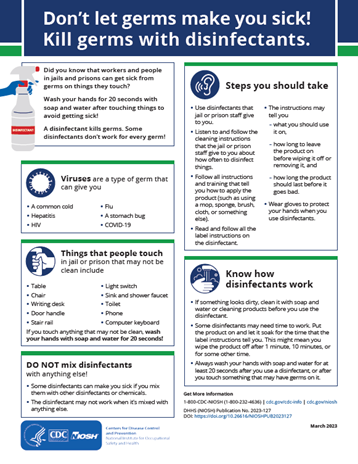National Correctional Workers Appreciation Week 2023
Posted on by
May 7-13, 2023, is National Correctional Officers Week also referred to as Correctional Workers Week. According to the Bureau of Labor Statistics, approximately 393,000 correctional officers and jailers worked inside correctional facilities in the United States in 2021.[1] The total number of correctional workers is likely much higher as facilities may also employ chaplains, healthcare providers, teachers, food service workers, and maintenance personnel. Correctional workers face a variety of workplace hazards and challenges including violence and physical assaults; strains, slips, trips, falls, or other injuries when responding to emergencies; motor vehicle-related injuries; sharps injuries; exposure to infectious diseases (e.g., HIV, hepatitis, TB); exposure to illicit drugs; and risks for work-related stress, depression, and suicide. The following information highlights National Institute for Occupational Safety and Health (NIOSH) and NIOSH-funded resources for correctional workers.
Fatalities and Injuries
The Bureau of Justice Statistics, the Bureau of Labor Statistics, and NIOSH produced a statistical report that included incidents of nonfatal workplace violence from 2015 to 2019. Correctional workers had the highest average annual victimization rate of nonfatal workplace violence (149 violent crimes per 1,000 workers compared to the average annual rate for all workers of 8.0 violent crimes per 1,000 workers).
Prior NIOSH research found that from 1999 to 2008, there were 113 fatalities and an estimated 125,200 nonfatal injuries among correctional officers treated in emergency departments. Assaults and violent acts (40%) and transportation related fatalities (40%) were the primary causes of correctional officer fatalities. Assaults and violent acts (38%) and body motion (i.e., slips and trips) and exertion (20%) were the leading nonfatal injury events among correctional officers.[2]
Stress and Mental Health
Research has shown that correctional officers experience high stress levels, burnout, and a variety of other mental health-related consequences as a result of their jobs.[3] The NIOSH Total Worker Health® Center for the Promotion of Health in the New England Workplace (CPH-NEW) is addressing the issues of stress and mental health among correctional officers. The Center hosts a National Symposium on Correctional Worker Health and conducts research and prevention activities. The NIOSH Total Worker Health Healthier Workforce Center of the Midwest has also examined these issues including Posttraumatic Stress Disorder and Job Burnout Among Jail Officers and Exploring How to Impact the Health and Safety of New Correction Officers: A Study of Rural and Urban Jails.
 Viral Surface Contamination
Viral Surface Contamination
Incarcerated persons frequently have higher rates of chronic conditions compared with the general population.[4] Illnesses can spread easily in shared (also called “congregate”) living conditions. Correctional workers are often assigned to work in shared spaces with incarcerated persons. If communal, high-touch surfaces are not properly cleaned and disinfected, correctional workers and people living in correctional facilities may be exposed to viruses that can cause illnesses such as a common cold, flu, and hepatitis A. NIOSH developed a Workplace Solutions document that recommends steps to reduce viral surface contamination through safe and proper use of disinfectants. Based on this document, NIOSH also designed an 8.5 x 11 free, printable companion poster providing recommendations in plain language for the safe use of disinfectants. The poster is also available in Spanish. To further provide outreach on this issue, NIOSH researchers have developed and conducted training with a state corrections agency in March 2023.
Needlesticks and Sharps Injuries
Common work tasks may expose correctional officers and correctional workers to needlesticks and other sharps injuries, putting them at risk for exposure to bloodborne pathogens including hepatitis B and C (HBV, HCV) and human immunodeficiency virus (HIV). Rates of infectious diseases are far higher among the incarcerated population compared with the general population (5 times higher for HIV, and 17–28 times higher for HCV). [4, 5] Needlesticks or sharps injuries may occur when correctional officers perform pat down searches of incarcerated or detained persons or conduct area searches throughout the facility. Click here for more information about bloodborne infectious diseases.
Ongoing Research
Several NIOSH programs conduct research to protect correctional workers from workplace injuries and illnesses. One of these programs is the Emergency Preparedness and Response Program. They work to improve the safety and health of public safety workers on the front line of emergency response. They also work with other NIOSH programs like the Public Safety Program whose mission is to reduce, prevent, or eliminate occupational exposures, injuries, illnesses, and fatalities among these workers through a focused program of research and prevention.
Sarah Hughes, MPH, is a Lieutenant in the U.S. Public Health Service and a Research Health Scientist in the NIOSH Division of Science Integration.
Grace Vixama, MPH, CHES, is a Lieutenant in the U.S. Public Health Service and is a health communications specialist in the NIOSH Division of Science Integration.
Resources
NIOSH Corrections Workers website
Workplace Solutions Document: Safe and Proper Use of Disinfectants to Reduce Viral Surface Contamination in Correctional Facilities
Safe and Proper Use of Disinfectants in Correctional Facilities (Poster available in English and Spanish)
Reducing Work-Related Needlestick and Other Sharps Injuries Among Law Enforcement Officers
NIOSH Emergency Preparedness and Response Program
References
[1] BLS [2021]. Occupational Employment and Wage Statistics. Washington, DC: U.S. Department of Labor, Bureau of Labor Statistics. https://www.bls.gov/oes/current/oes333012.htm
[2] Konda S, Reichard A, Tiesman H [2012]. Occupational Injuries among U.S. Correctional Officers, 1999-2008. J Safety Res 43 (3):181-186. https://doi.org/10.1016/j.jsr.2012.06.002
[3] NIJ [2017]. Correctional officer safety and wellness — what we learned from the research literature. July 23. Washington, DC: U.S. Department of Justice, Office of Justice Programs, National Institute of Justice.
https://nij.ojp.gov/topics/articles/correctional-officer-safety-and-wellness-what-we-learned-research-literature
[4] DHHS [no date]. Healthy people 2030: incarceration. Social determinants of health. Washington, DC: U.S. Department of Health and Human Services. https://health.gov/healthypeople/priority-areas/social-determinants-health/literature-summaries/incarceration
[5] Flanigan TP, Zaller N, Taylor L, Beckwith C, Kuester L, Rich J, Carpenter CCJ [2009]. HIV and infectious disease care in jails and prisons: breaking down the walls with the help of academic medicine. Trans Am Clin Climatol Assoc 120:73–83.
Posted on by

